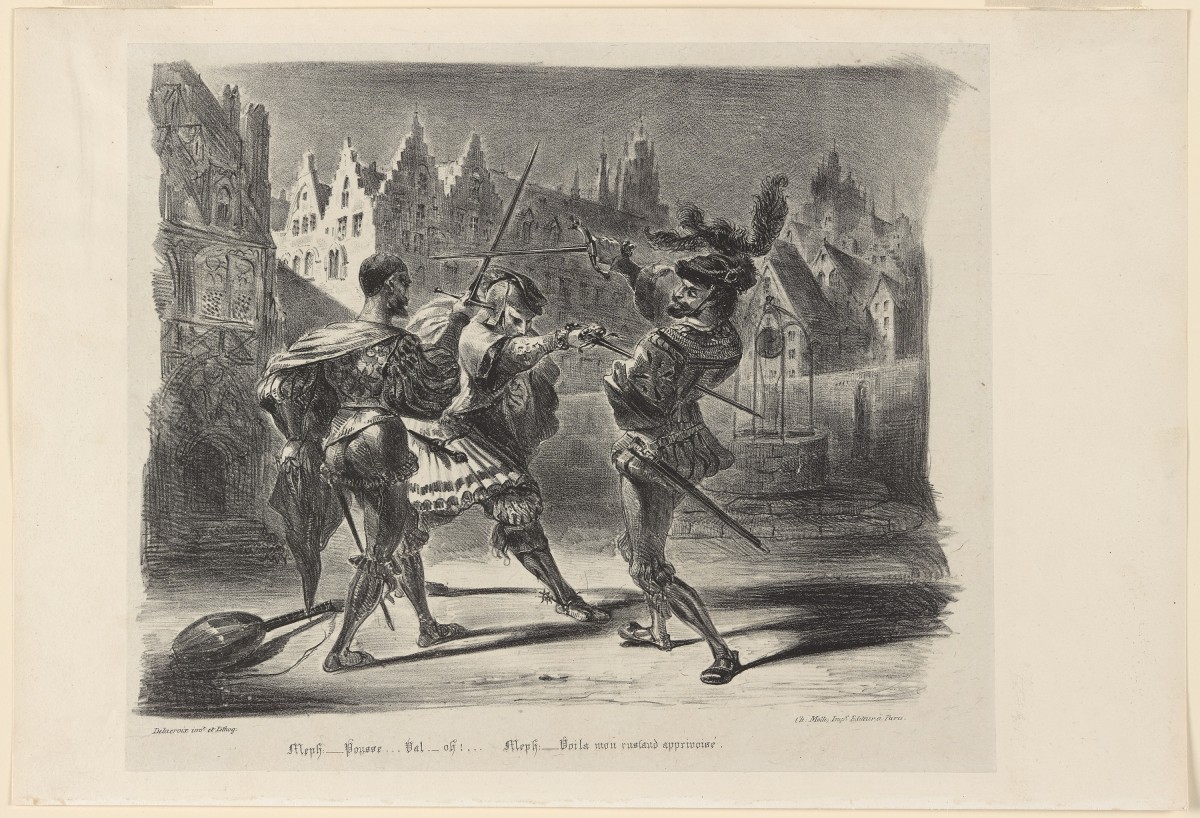Drawn to Faust
A game changer in French printmaking, Delacroix and Faust: The Good, The Bad, and ‘the Ugly’ gives new meaning to the phrase the devil is in the details.

Eugene Delacroix, The Duel Between Faust and Valentine, 1829, from Johann Wolfgang von Goethe’s Faust, lithograph, printed chine colle. Art Gallery of Ontario. Gift from the Richard and Joan Ivey Fund, 1979
In 1828, French artist Eugène Delacroix (1798-1863) created a series of seventeen lithographs to illustrate a French translation of Johann Wolfgang von Goethe’s epic-poem, Faust. These incredible works on paper, on view now on Level 1 of the AGO, depict the tragic doings of a man named Faust, who makes a deal with the devil in exchange for superhuman knowledge and power.
For all its intensity and detail, and despite the notoriety Delacroix’s painting Death of Sardanapalus had garnered at the 1828 Paris Salon, the project was a commercial and critical flop. Faust wasn’t his only failure in this area − his illustrated Hamlet and scenes from Ivanhoe, published later in his life, fared almost as bad.
Certainly, contemporary art historians value them: “Delacroix’s inventive lithographs,”, says Riva Castleman, author of A Century of Artists’ Books, “announced a definitive change in the attitude of artists toward working in the book form”, in so much as they presented the artist’s contribution as equal, if not somewhat superior. Their scale is impressive − each lithograph was a separate full page, requiring the publisher to print them separately and insert them into the body of the book.
So what, then, accounted for the book's lack of success? Fascinated, we present three possibilities, which unlike Faust, we won’t bet our life on.
-
Was it the format? Lithography in 1828 was a new medium. Very new. Invented by the German actor and playwright Alois Senefelder in 1798, its capacity for strong contrast likely took people by surprise. Using the maniere noir technique, which he perfected in the 1820s, Delacroix scratched through a coating of lithographic crayon to create his dramatic images, each commanding a full page. Gone were the tonal gradations and soft grays of yore. He was a man “passionately in love with passion”, said the poet Charles Baudelaire," but coldly determined to express passion as clearly as possible."
-
Was it the story itself? It’s certainly a page-turner, replete with duals and seductions and soul-damning consequences. And it was very popular − Delacroix himself saw a stage version in London before he began the project and was apparently entranced. But German literature, with all its romantic ideals of a complex inner life, and by extension Goethe, was very new to French audiences in 1828. It was the great French intellectual Germaine de Staël, and her book De l'Allemagne (On Germany) who introduced Parisians to Goethe. She was determined to make him a star and even published her book twice, issuing 10,000 copies in 1810, all of which were destroyed by order from Napoleon, and then again in 1813, in joyful protest.
-
Was it personal? In an August 1825 edition of the French newspaper Le Figaro, Delacroix is disparaged for embodying all the qualities of the Romantic Movement, notably their “lack of restraint, exaggeration, lack of taste, a sort of libertine license that people saw as boldness and the arrogance of believing himself to be a genius because he dispensed with any form of training or rules of any kind.” Certainly, as the greatest exponent of the French Romantic school, it’s very possible his avant-garde reputation and not his efforts, got in the way. Indeed, it wasn’t until his eighth attempt that he was admitted into the Academy of Fine Arts, and then only with help from a well-connected patron.
But for all that − and we may never really know why these failed to catch his contemporaries' attention - Delacroix did manage to impress one person at least. Goethe himself, who would remark that “Delacroix has surpassed my own vision.”
Admission to Delacroix and Faust: The Good, The Bad, and ‘the Ugly’ is free for visitors 25 and under, AGO Members and Annual Passholders. Stay tuned to AGOinsider for more exciting stories about prints and drawings and works from the AGO Collection.
